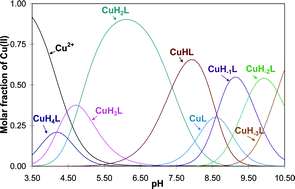Coordination of copper(ii) ions by the fragments of neuropeptide gamma containing D1, H9, H12 residues and products of copper-catalyzed oxidation†
Abstract
A potentiometric, spectroscopic (

* Corresponding authors
a Faculty of Chemistry, University of Gdansk, Sobieskiego 18, Gdansk, Poland
b
Faculty of Chemistry, University of Wroclaw, Joliot-Curie 14, Wroclaw, Poland
E-mail:
TerKow@wchuwr.chem.uni.wroc.pl
Fax: (048)(71)3282348
Tel: (048)(71)3757231
A potentiometric, spectroscopic (

 Please wait while we load your content...
Something went wrong. Try again?
Please wait while we load your content...
Something went wrong. Try again?
E. Jankowska, M. Pietruszka and T. Kowalik-Jankowska, Dalton Trans., 2012, 41, 1683 DOI: 10.1039/C1DT10592B
To request permission to reproduce material from this article, please go to the Copyright Clearance Center request page.
If you are an author contributing to an RSC publication, you do not need to request permission provided correct acknowledgement is given.
If you are the author of this article, you do not need to request permission to reproduce figures and diagrams provided correct acknowledgement is given. If you want to reproduce the whole article in a third-party publication (excluding your thesis/dissertation for which permission is not required) please go to the Copyright Clearance Center request page.
Read more about how to correctly acknowledge RSC content.
 Fetching data from CrossRef.
Fetching data from CrossRef.
This may take some time to load.
Loading related content
